
???
PowerBook
User???sGuide
Includes setup and important

???
PowerBook
User???sGuide
Includes setup and important
K Apple Computer, Inc.
?? 1994 Apple Computer, Inc. All rights reserved.
Under the copyright laws, this manual may not be copied, in whole or in part, without the written consent of Apple. Your rights to the software are governed by the accompanying software license agreement.
The Apple logo is a trademark of Apple Computer, Inc., registered in the U.S. and other countries. Use of the ???keyboard??? Apple logo
Every effort has been made to ensure that the information in this manual is accurate. Apple is not responsible for printing or clerical errors.
Apple Computer, Inc. 1 Infinite Loop
Cupertino, CA
Apple, the Apple logo, LaserWriter, LocalTalk, Macintosh, PowerBook, and StyleWriter are trademarks of Apple Computer, Inc., registered in the U.S. and other countries.
Apple Desktop Bus, Balloon Help, Finder, and PowerBook Duo are trademarks of Apple Computer, Inc.
Adobe, Adobe Illustrator, and PostScript are trademarks of Adobe Systems Incorporated, registered in the United States. Adobe Photoshop is a trademark of Adobe Systems Incorporated.
Exposure is a registered trademark of Preferred Publishers, Inc.
QMS is a registered trademark of QMS, Inc.
QuarkXPress is a registered trademark of Quark, Inc.
SuperPaint is a registered trademark of Aldus Corporation.
Tektronix is a registered trademark and Phaser is a trademark of Tektronix, Inc.
Simultaneously published in the United States and Canada.
Mention of

Contents
iii

Contents v

Communications regulation information
FCC statement
This equipment has been tested and found to comply with the limits for a Class B digital device in accordance with the specifications in Part 15 of FCC rules. See instructions if interference to radio or television reception is suspected.
Radio and television interference
The equipment described in this manual generates, uses, and can radiate
This equipment has been tested and found to comply with the limits for a Class B digital device in accordance with the specifications in Part 15 of FCC rules. These specifications are designed to provide reasonable protection against such interference in a residential installation. However, there is no guarantee that interference will not occur in a particular installation.
You can determine whether your computer system is causing interference by turning it off. If the interference stops, it was probably caused by the computer or one of the peripheral devices.
If your computer system does cause interference to radio or television reception, try to correct the interference by using one or more of the following measures:
mTurn the television or radio antenna until the interference stops.
mMove the computer to one side or the other of the television or radio.
mMove the computer farther away from the television or radio.
mPlug the computer into an outlet that is on a different circuit from the television or radio. (That is, make certain the computer and the television or radio are on circuits controlled by different circuit breakers or fuses.)
If necessary, consult an
IMPORTANT Changes or modifications to this product not authorized by Apple Computer, Inc., could void the FCC Certification and negate your authority to operate the product.
This product was tested for FCC compliance under conditions that included the use of Apple peripheral devices and Apple shielded cables and connectors between system components. It is important that you use Apple peripheral devices and shielded cables and connectors between system components to reduce the possibility of causing interference to radios, television sets, and other electronic devices. You can obtain Apple peripheral devices and the proper shielded cables and connectors through an
vi Communications Regulation Information

DOC statement
DOC Class B Compliance This digital apparatus does not exceed the Class B limits for radio noise emissions from digital apparatus as set out in the
Observation des
VCCI statement





 Speaker
Speaker
Trackball

 ?? Brightness controls
?? Brightness controls

Follow the instructions in this
chapter to set up your computer
and learn the basics.
1 Getting Started
The illustration on the facing page provides an overview of your PowerBook computer. To set up your PowerBook for the first time, you need the power adapter and the power cord that came with your computer.
When setting up your computer, place your computer on a sturdy, flat surface near a grounded electrical outlet. Before following the setup instructions in this chapter, you may want to read ???Arranging Your Work Area and Equipment??? in Appendix A for tips on adjusting your work furniture and computer so that you???re comfortable when using the computer.
Plugging in the computer
Plugging in the power adapter recharges the computer???s batteries. You should plug in the power adapter in case the battery has drained during shipping or storage.
WARNING Use only the power adapter that came with your PowerBook. Adapters for other electronic devices (including other portable computers) may look similar, but they may damage your computer.
1

When you are ready to begin:
1Plug one end of the power cord into the power adapter and the other end into a three- hole grounded outlet or power strip.
WARNING This equipment is intended to be electrically grounded. Your PowerBook is equipped with a
2Plug the power adapter cable into the power adapter port (marked with the icon ??) on the back panel of the computer.
You can wind extra cable around the hooks that open out from the power adapter.
Power cord
Power adapter
Wrap cable around the hooks.
Depending on where you purchased your computer, you may also have received a wall mount plug. You can use this plug instead of the power cord to plug the power adapter directly into an electrical outlet.
2 Chapter 1

Opening the display
1 Slide the latch to the right and lift up the display.
2Position the display at a comfortable viewing angle.
You can adjust the angle of the display at any time by tilting it towards or away from you.
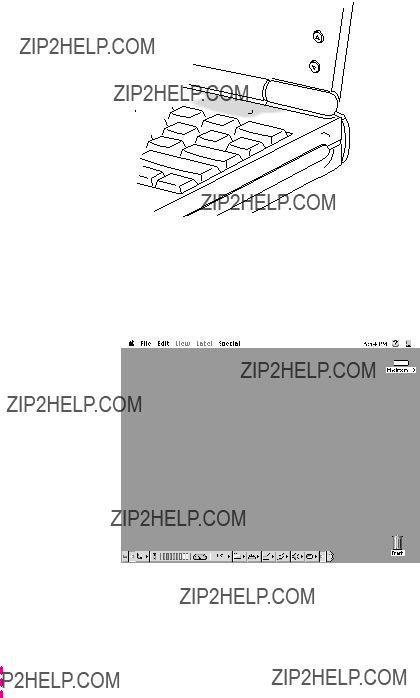
Turning on the computer
To turn on the computer for the first time:
m Press the Power On key above the keyboard.

 Power On key
Power On key
You should hear a tone when you turn on the computer. It takes the computer a moment to start up.
When you see something like this on your screen, the computer is ready to use:
Note: Your screen should look very similar to this picture but it might not look exactly the same.
4 Chapter 1

Problems turning on your computer?
mThe computer made a sound, but you can???t see anything on the screen.
Adjust the brightness control buttons until an image appears and the screen is easy to read.
Brightness
mNothing happened when you pressed the Power On key.
Make sure the power adapter is firmly connected to both the computer and a power source. If the power adapter is plugged into a power strip, make sure the power strip is plugged in and turned on. Then try pressing the Power On key again.
If you still get no results, press the power button on the back of the computer.
 Power button
Power button
If neither the Power On key nor the power button turns the computer on, see the PowerBook Troubleshooting Guide you received with your computer for help.

mYou see a picture of a disk with a blinking question mark on the screen.
This picture means that you need to install system software on the computer???s hard disk. System software includes the programs the computer uses to start itself up. You received a set of system software disks in the accessory kit that came with your computer. For instructions on installing system software, see the PowerBook Troubleshooting Guide you received with your computer.
6 Chapter 1

What???s next?
You???ve now finished setting up your PowerBook. Continue with one of the following steps:
mIf you are new to the Macintosh, turn to the next section, ???Learning the Basics.???
mIf you are an experienced Macintosh user, turn to Chapter 2, ???Getting Help,??? to learn about Macintosh Guide, your main source of information when you???re working with the Macintosh.
mIf you have additional equipment to connect to your computer, see Chapter 3, ???Connecting Additional Equipment,??? for instructions. (If you are a new Macintosh user, you should complete ???Learning the Basics??? before connecting additional equipment.)
mIf you have application programs that you want to install on your computer, see Chapter 4, ???Installing and Using Application Programs,??? for instructions. (If you are a new Macintosh user, you should complete ???Learning the Basics??? before installing application programs.)
IMPORTANT If you need to turn off your computer at any point, read the instructions in ???Turning the Computer Off??? later in this chapter to learn the correct procedure for turning off your PowerBook.
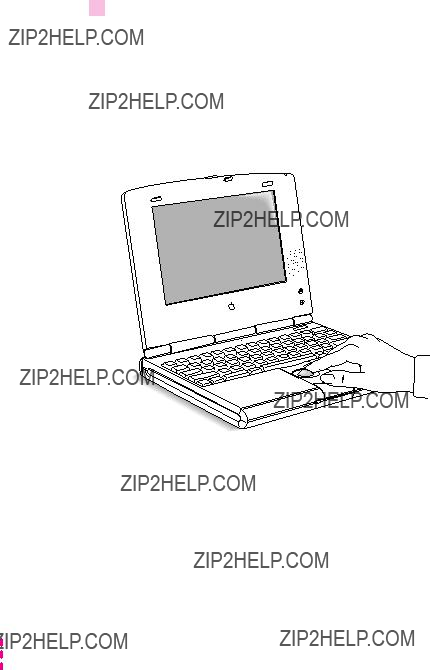
Learning the basics
If you are new to the Macintosh, you should begin by looking at the
1Roll the trackball to move the arrow pointer (8) on the screen.
Place your index finger on the trackball and your thumb on the lower trackball button. Don???t press either button yet.
Roll the trackball, watching the arrow on the screen. Notice that the arrow moves in the same direction as you roll the trackball.
You may need to roll the trackball around for a few seconds to ???break in??? the mechanism so it works smoothly.
8 Chapter 1

2Roll the trackball so that the tip of the arrow (8) points to the question mark in the upper- right portion of the screen.
3With the tip of the arrow (8) on the question mark, press and hold down the trackball button.
A list of choices (called a menu) appears. This is the Guide menu, which is the place to go when you have a question about how to use your computer.
4While holding down the trackball button, move the arrow (8) until the words ???Macintosh
Tutorial??? are highlighted, then release the trackball button.
A window appears welcoming you to the tutorial. You can set aside this book for now and follow the instructions you see on the screen. When you have completed the tutorial, return to this book.

Reviewing the basics
The following illustration summarizes many of the basic skills and terms you learned from the tutorial.
The strip across the top of the screen is called the menu bar. The symbols and words in it represent menus of commands.
Icons are small pictures that represent disks,
You can have several application programs open at once. To see which program is active or to switch from one program to another, use this menu (called the Application menu).
This icon represents your computer???s internal hard disk.
folders, programs, and documents. To open an icon, click the icon twice quickly.
Windows are boxes that display text, graphics, or icons. To bring a partially covered window to the front, click anywhere in the window.
To change the size or shape of a window, drag the size box.
To throw away an item you no longer want, drag it to the Trash and choose Empty Trash from the Special menu.
The Control Strip gives you a quick and easy way to monitor and update your PowerBook???s power management options. For instructions on using the Control Strip, see the ???Batteries & Power??? topic of Macintosh Guide, available in the Guide (h)menu.
10 Chapter 1
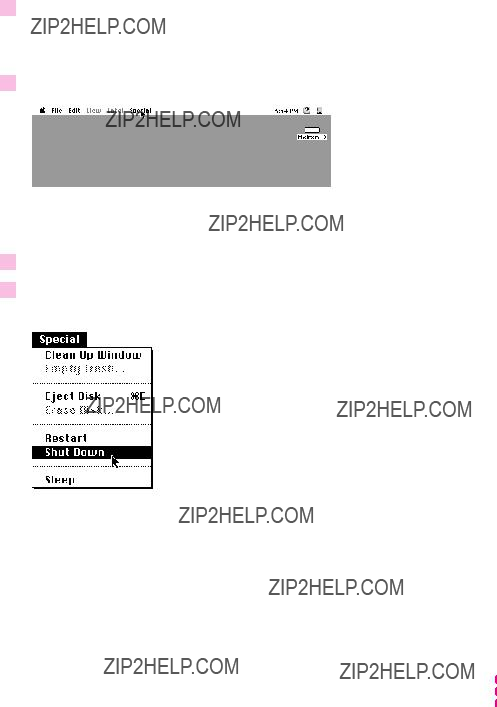
Turning the computer off
To turn the computer off, you choose Shut Down from the Special menu.
Detailed instructions follow.
1If the computer is in sleep, press any key on the keyboard (except Caps Lock) to wake it.
For information on the sleep feature of your PowerBook, see ???Putting the Computer to Sleep??? on the next page.
2Move the tip of the arrow to the word ???Special??? at the top center of the screen.
If the word ???Special??? does not appear at the top of the screen, you???re working in the wrong program. Click anywhere on the desktop.
3With the tip of the arrow on the word Special, press and hold down the trackball button.
4While holding down the trackball button, move the arrow until the words ???Shut Down??? are highlighted, then release the button.
Trouble? If a problem with the computer prevents you from choosing Shut

Putting the computer to sleep
Sleep is a power conservation feature of PowerBook computers, reducing the amount of power the computer draws when it???s not being used. When the PowerBook is in sleep, it has a darkened screen and appears to be off. If you have a PowerBook Duo 280c, a green light flashes on the top of the display case when your computer is in sleep.
To put the computer to sleep:
mChoose the Sleep command from the Special menu. (The computer must be on in order for you to put it to sleep.)
For information on other ways of putting the computer to sleep, see the ???Batteries & Power??? topic of Macintosh Guide, available in the Guide (h) menu. (You can learn about using Macintosh Guide in Chapter 2 of this manual.)
Automatic sleep
If you don???t use the computer for several minutes, it goes to sleep automatically. This conserves battery power.
To wake the computer, press any key on the keyboard (except Caps Lock). The screen will reappear as it was before the computer went to sleep.
You can control the automatic sleep feature. For more information on sleep and automatic sleep, see the ???Batteries & Power??? topic of Macintosh Guide, available in the Guide (h) menu. (You can learn about using Macintosh Guide in Chapter 2 of this manual.)
12 Chapter 1

Restarting a computer that???s already on
You need to restart your
You also need to restart if you see a ???system error??? message on the screen (indicating a temporary software problem). In this case, use the trackball to click the Restart button that appears.
To restart your computer:
m Choose Restart from the Special menu.
If the Special menu does not appear in the menu bar, you???re working in the wrong program. Click anywhere on the desktop.
When you choose Restart, the computer prompts you to save your work, closes all open programs, and restarts itself.
Choosing Restart does not affect your RAM disk (if you created one) or its contents.
Trouble? If a problem with the computer prevents you from choosing

Where to find answers
When you have questions about using your PowerBook, there are several places you can look for answers:
In this book
Use this book to set up and learn about your computer.
PowerBook
User???sGuide
PowerBook
Troubleshooting
Guide
In the Guide menu
The Guide menu (marked with the h symbol) is your main source of information about the Macintosh. To learn how to get different kinds of help from the Guide menu, refer to Chapter 2 of this book.
In the PowerBook Troubleshooting Guide
The PowerBook Troubleshooting Guide is a portable manual that provides useful tips and suggestions if you have problems while using your computer.
In other manuals
For answers to questions about other equipment or application programs you have purchased, see the manuals that came with them.
From Apple???s customer support hotline
If you can???t find an answer in any of the materials provided, call the customer support hotline. (The phone number for the hotline is in the service and support information that came with your computer.)
14 Chapter 1

Use the instructions in this chapter to learn about the help available to you in the Guide menu.
2 Getting Help
The Guide menu is your main source of information when you???re working with your computer. The menu is identified by a question mark (h) in the
15

Getting answers to your questions
When you have a question while working with your computer, you can get the answer by choosing Macintosh Guide from the Guide menu.
1Pull down the Application menu (in the
A checkmark in the menu indicates that the Finder is the active program.
2 Pull down the Guide menu (marked with the h icon) and choose Macintosh Guide.
The Macintosh Guide window appears.
Whenever you use Macintosh Guide, its window remains in front of other windows. If the window gets in your way, you can move it by dragging its title bar (the gray bar across the top of the window).
16 Chapter 2

3 Notice the three buttons at the top of the window: Topics, Index, and Look For.
Macintosh Guide gives you three ways of finding information:
mTopics lets you choose from a list of general subjects; it is like the table of contents in a book.
mIndex lets you choose from an alphabetical list of more specific subjects; it is like the index in a book.
mLook For lets you search for information related to a specific word or phrase that you type.
In the following sections you will practice using each method.
If you have problems while using Macintosh Guide, see ???Tips for Using Macintosh Guide??? later in this chapter.
Getting answers with the Topics button
1In the Macintosh Guide window, click the Topics button.
A list of general topics appears on the left side of the Macintosh Guide window. (Depending on the hardware and software you have, the list of topics may look different.)
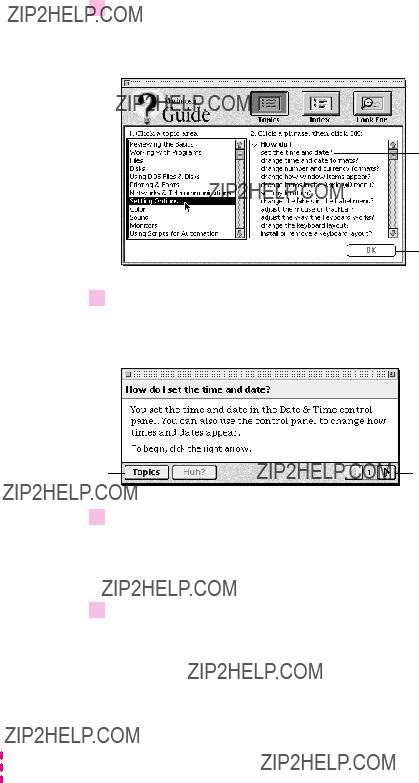
2Click ???Setting Options??? in the list of topics.
When you click any topic area, a list of related questions appears on the right side of the Macintosh Guide window.
To get instructions, click a question???
???and then click OK.
3Click the question ???How do I set the time and date???? and then click OK. Or
A small window appears with instructions for you to follow.
If you want to return to the main Macintosh Guide window, click here.
Click here to see the next step (if there is one).
4Read and follow the instructions in this window.
Macintosh Guide provides
5When you have completed all the steps, click the Topics button in the
Now continue with the next section.
18 Chapter 2

Getting answers with the Index button
1In the Macintosh Guide window, click the Index button.
An alphabetical list of subjects appears on the left side of the window.
Slider
Scroll bar
2Scroll through the alphabetical list until the phrase ???background pattern??? is visible.
You can scroll through the list either by dragging the slider to the letter B or by using the scroll bar at the right of the list.
3Click the phrase ???background pattern??? in the alphabetical list.
When you click any index entry, a list of related questions appears on the right side of the Macintosh Guide window.
To get instructions, click a question???
???and then click OK.

4Click the question ???How do I change the background pattern???? and then click OK. Or
A small window appears with instructions for you to follow.
If you want to return to the main Macintosh Guide window, click here.
Click here to see the next step (if there is one).
5Read and follow the instructions in the window.
Macintosh Guide provides
6When you have completed all the steps, click the Topics button in the
Now continue with the next section.
20 Chapter 2

Getting answers with the Look For button
1In the Macintosh Guide window, click the Look For button.
A small box appears on the left side of the window, where you can type text.
To activate the text box, click here.
Type a word or phrase  in the text box???
in the text box???
???and then click here.
2Click the arrow button to activate the text box.
3Type ???sound??? in the text box and then click Search.
When you click Search, a list of questions related to the word or phrase you typed appears on the right side of the Macintosh Guide window.
To get instructions, click a question???
???and then click OK.

4Click the question ???How do I change the beep sound???? and then click OK. Or double- click the question.
A small window appears with instructions for you to follow.
If you want to close Macintosh Guide, click here.
Click here to see the next step (if there is one).
5Read and follow the instructions in the window.
Macintosh Guide provides
6When you have completed all the steps, click the close box in the
22 Chapter 2

Tips for using Macintosh Guide
Here are a few tips for using Macintosh Guide effectively:
mMacintosh Guide is available only when you are in the
mFollow the steps when you???re instructed to; don???t skip ahead or read ahead. That way the computer can check to make sure you???ve done a step correctly.
mUnlike most windows, the Macintosh Guide window stays in front of other windows on the screen so that your instructions are never covered. If you need to move the Guide window out of the way, drag it by the title bar at the top of the window.
You can also move the window out of the way by clicking the zoom box. Click the box once to shrink the window; click it a second time to expand the window to its original size.
mIf you need more information about an instruction or a term, click the button labeled ???Huh???? to get further explanation. (The ???Huh???? button is dimmed when no additional information is available.)
mIf you want to return to the main Macintosh Guide window, click the Topics button in the
mWhen you???re finished using Macintosh Guide, click the close box in the
Zoom box
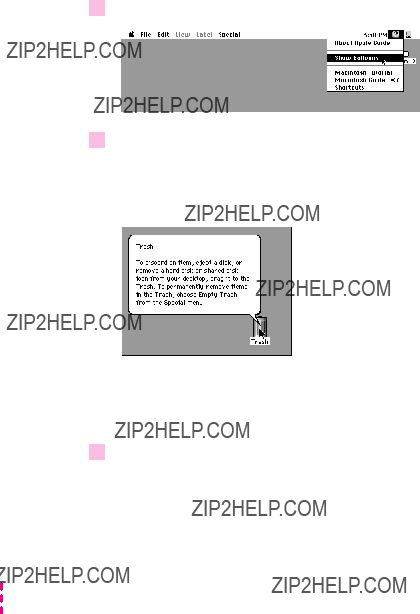
Identifying objects on the screen
Sometimes you???ll see an unfamiliar item on the screen and ask yourself, ???What???s that???? You can get an answer by using a Macintosh feature known as Balloon Help.
Balloon Help explains the function of icons, menus, commands, and other items on the Macintosh screen in balloons like those you see in comic strips.
Follow these steps to use Balloon Help:
1 Pull down the Guide menu (marked with the h icon) and choose Show Balloons.
2Point to any object on the screen that you want to identify.
A balloon appears next to the object. In the following illustration, for example, pointing to the Trash displays a balloon that explains how to use the Trash to throw items away.
Although balloons appear next to items when you point to them, the way you work does not change; you can still select icons, choose commands, and so on.
3 When you???re finished using Balloon Help, choose Hide Balloons from the Guide menu.
24 Chapter 2

Learning useful shortcuts
You can perform many tasks in the Finder more quickly if you use keyboard or mouse shortcuts. For example, instead of clicking an icon and choosing Open from the File menu, you can simply
Follow these steps to learn keyboard and mouse shortcuts:
1Pull down the Guide menu (marked with the h icon) and choose Shortcuts.
The main Macintosh Shortcuts window appears.

2Click one of the category buttons.
Another window appears, describing shortcuts for that category.
If you want to close the window, click here.
Click here to return to the main Macintosh Shortcuts window for more categories.
Click here to see the next window (if there is one).
3Read about the shortcuts available for the category you selected.
Click the right arrow in the
4When you finish reading about the shortcuts for your category, click the Topics button in the
26 Chapter 2

Read this chapter for information on
expanding your computer system
with additional hardware.
3 Connecting Additional Equipment
The illustration below shows where equipment can be connected to your computer. Refer to the manuals that came with your equipment for instructions on connecting it.
27

In addition to connecting certain equipment directly to your PowerBook, you can also expand your system with the following accessories:
mthe PowerBook Duo Dock and Duo Dock II
mthe PowerBook Duo MiniDock
mthe PowerBook Duo Floppy Adapter
A brief overview of these accessories is in this chapter. For more information, see the documentation that comes with them. You can purchase any of these products from an
The PowerBook Duo Dock and Duo Dock II
The PowerBook Duo Dock and Duo Dock II are the most versatile expansion options for PowerBook 200 Series computers. A dock is itself not a
The drawing below shows where you can connect a variety of devices to a Duo Dock II.
I Power button
28 Chapter 3

The Duo Dock and Duo Dock II come with many
man internal 1.4 MB floppy disk drive
man optional internal SCSI hard disk drive (any available capacity that meets Apple???s specifications; up to 1 inch high)
mstandard ports including SCSI (with an
ma separate mouse and keyboard
mslots for two NuBus cards for Ethernet, Token Ring, additional video, or other capabilities. (Note that if you use two NuBus cards in your Duo Dock or Duo Dock II, the bottom of your PowerBook may feel warm when you eject it from the dock. This is normal and will not harm your PowerBook.)
m
m1 MB VRAM for
man automatic insert/eject feature to ensure reliable docking
ma
ma slot door that protects the interior of your Duo Dock II when your PowerBook is not docked
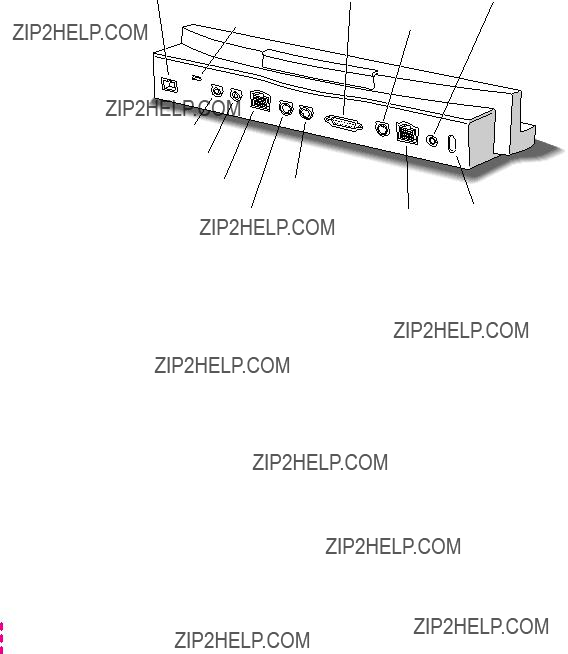
The PowerBook Duo MiniDock
The PowerBook Duo MiniDock allows you to connect a wide variety of devices to the PowerBook. Like the Duo Dock, the minidock with peripheral devices connected to it is not a
The minidock attaches to the back of the PowerBook and allows you to use the following types of equipment with your computer:
ma variety of Apple monitors
mup to three Apple Desktop Bus (ADB) input devices (such as a keyboard or mouse)
man external 1.4 MB floppy disk drive
mup to six SCSI devices, including hard disk drives,
ma printer
man external modem
mLocalTalk cables
mexternal microphone, headphones, or speakers
30 Chapter 3
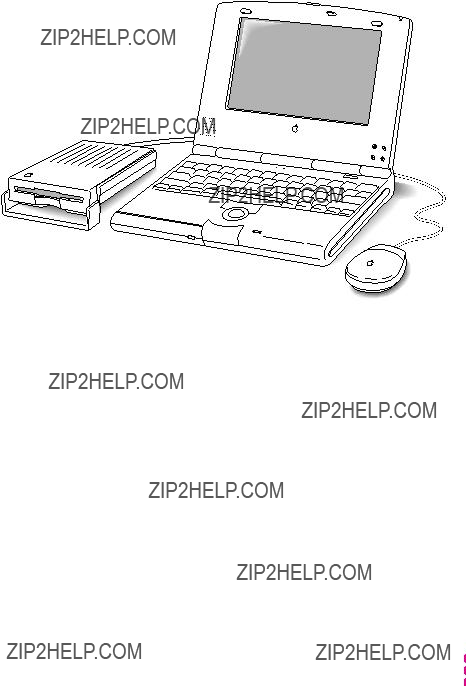
The PowerBook Duo Floppy Adapter
The PowerBook Duo Floppy Adapter allows you to connect an external 1.4 MB floppy disk drive
Connecting a printer
The printer/modem port (??) on your PowerBook can accept either a direct connection (to a printer such as a StyleWriter) or a network connection (to a printer such as a LaserWriter). If you are connecting a printer to the port, make sure that the modem selection in the Express Modem control panel is set to Use External Modem. See the next section, ???Connecting a Modem,??? for details.

Connecting a modem
Apple offers optional,
You can also connect an external modem to any of the following:
mthe printer/modem port on the PowerBook
mthe modem port on a Duo MiniDock
mthe modem port on a Duo Dock
To connect an external modem, follow these steps.
1Make sure the computer is in sleep or shut down.
2Connect the modem to a power source and to the phone line.
See the documentation that came with the modem.
3Make sure the modem is turned off.
4Connect the modem cable to the printer/modem port (PowerBook) or the modem port (Duo Dock or Duo MiniDock).








 Printer/modem port icon
Printer/modem port icon

 Modem port icon
Modem port icon
5Turn on the modem.
6Wake or restart the computer.
If your computer does not have an internal modem, the external modem is ready to use.
If your computer does have an internal modem, continue with step 7.
32 Chapter 3
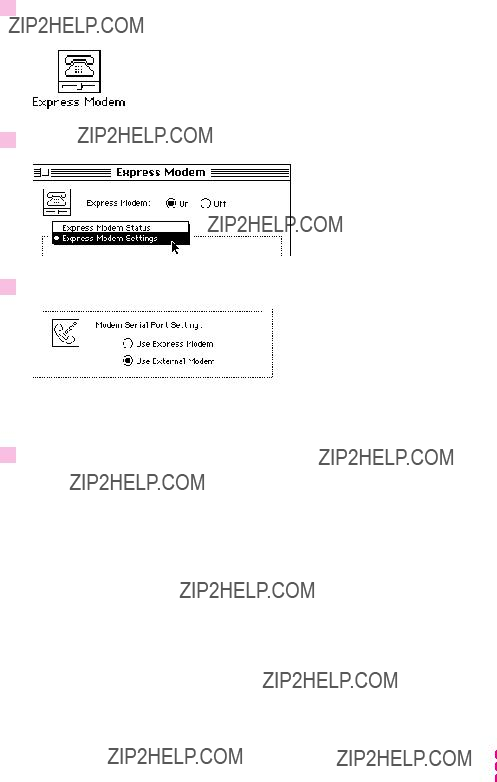
7Choose Control Panels from the Apple (K) menu and open the Express Modem control panel.
8 Choose Express Modem Settings from the
9 Click Use External Modem to activate the external modem.
Leave Use External Modem selected even when you use your internal modem.
10Close the control panel.
The external modem is ready to use.
If you don???t have the Express Modem control panel: The Express Modem control panel is part of version 1.5 of the Express Modem software. If you have an earlier version of Express Modem software, or if you have another kind of internal modem, you can activate an external modem by opening the PowerBook Setup control panel and clicking the Normal button.
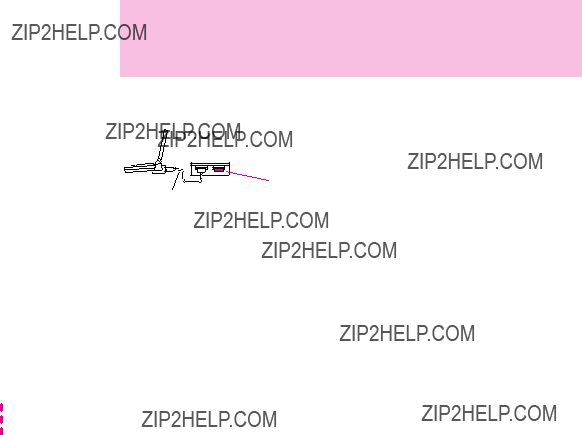
Connecting SCSI devices
A SCSI device is any
You can attach up to 6 SCSI devices to your computer by linking them together in a chain that starts at your dock???s SCSI port. There is a SCSI port on the PowerBook Duo Dock and the PowerBook Duo MiniDock. (There is no SCSI port on PowerBook 200 Series computers.)
To connect a SCSI device to your PowerBook, you need an Apple
Refer to the manuals that came with your SCSI devices for instructions on installing any necessary software, setting SCSI ID numbers, and connecting SCSI cables and SCSI terminators. Refer to the illustrations below for the proper positioning of SCSI terminators.
WARNING When connecting SCSI equipment, always turn off power to all devices in the chain, including your computer. If you don???t, you could lose information and damage your equipment.
Where to add cable terminators when connecting a single SCSI device:
Terminator
34 Chapter 3

Where to add cable terminators when connecting two or more SCSI devices:
Using your PowerBook as a SCSI disk
If you have a PowerBook Duo MiniDock, you can purchase a cable called the Apple
The Apple
The PowerBook Duo Dock and Duo Dock II do not support SCSI disk mode.
WARNING Follow the steps for connecting and disconnecting SCSI devices carefully to avoid loss of information and damage to your equipment.

Connecting your computer as a SCSI disk
Before making any connections, you need to assign a unique SCSI ID number to the PowerBook. (The unique ID number allows the computer to communicate with several connected devices.)
1Choose Control Panels from the Apple (K) menu of your PowerBook computer.
2Open the PowerBook Setup control panel.
3In the SCSI Disk Mode section of the control panel, click the ID number you want to assign.
If you are connecting the PowerBook to an existing SCSI chain, make sure to give it an ID number different from those of the other devices. (Many devices include an ID number indicator on the back panel.)
4Close the PowerBook Setup control panel.
5Turn off the PowerBook by choosing Shut Down from the Special menu.
6Shut down the computer you are connecting to, and turn off any other devices in the SCSI chain.
7Connect the small connector on the Apple
8If you are connecting the PowerBook directly to the other computer (rather than to an external device in the SCSI chain), attach a SCSI system cable to the other computer.
9Connect the large connector on the Apple
36 Chapter 3

Remove the terminator from the last device before connecting the PowerBook. (If the last device has an internal terminator, disconnect the device and connect the PowerBook to the end of the SCSI chain. An Apple- authorized service provider can remove the terminator.)
WARNING Always shut down the PowerBook before connecting or disconnecting the SCSI disk adapter cable. Connecting the adapter cable while the computer is turned on can damage the computer.
10Turn on the PowerBook by pressing the power button.
After a few seconds a SCSI icon appears on the screen, showing the ID number you assigned in step 3.
WARNING If you do not see the SCSI icon, and the computer starts normally or displays an error message, choose Shut Down (if you can) and then immediately disconnect your computer from the SCSI chain. (If you can???t choose Shut Down, try pressing the power button. If you cannot shut down your PowerBook, you should disconnect the cable anyway, or you may lose information.) Then go back and repeat steps 6 through 10, making sure to use the proper cables.
11Turn on the other SCSI devices in the chain, if any.
12Turn on the other computer.
The PowerBook appears as a hard disk icon on the desktop of the computer you connected it to. You can now transfer and use files as if the PowerBook were an external disk drive.
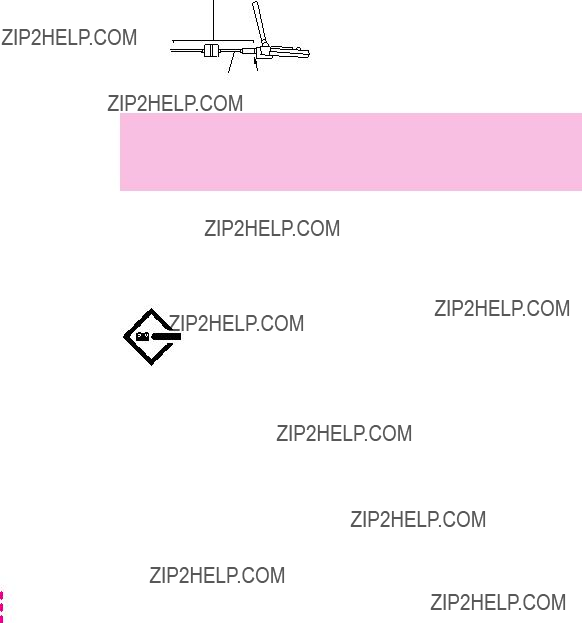
Simplifying the connection process
If you regularly plan to use your PowerBook as a SCSI disk with the same computer, you can leave the SCSI disk adapter cable attached to the other computer or its SCSI chain. When you want to use your PowerBook as a SCSI disk, simply shut down all devices and connect the adapter cable to the SCSI port on your PowerBook Duo MiniDock.
These cables can stay attached to your other computer or its SCSI chain.
WARNING Always disconnect your PowerBook from the adapter cable when you are not using it as a SCSI disk. Your PowerBook will not work correctly if the adapter cable remains attached.
Drawing battery power in SCSI disk mode
Your PowerBook continues to draw battery power when you use it as a SCSI disk. Low battery power is indicated by a blinking
If you see this warning while using your computer as a SCSI disk, either plug in the power adapter or quit SCSI disk mode, as described in the next section, so you can remove the battery for recharging.
38 Chapter 3

Quitting SCSI disk mode
1Shut down the computer your PowerBook is connected to.
2Turn the PowerBook off by holding down the Command (x) key and the Power On (P) key at the same time.
3Turn off any other SCSI devices in the chain.
4Disconnect the PowerBook from the adapter cable.
If you regularly plan to connect your PowerBook to the same computer, you can leave the adapter cable attached to the SCSI chain or the other computer.
IMPORTANT Do not leave the adapter cable attached to the PowerBook. If you do, the computer will behave as though it is still in SCSI disk mode when you try to restart.
5If necessary, disconnect the adapter cable from the other computer or its SCSI chain.
Your equipment is now ready for normal use. Make sure that the SCSI chain is properly terminated.

Connecting other devices
For instructions on connecting a device not discussed in this
Adding memory to your computer
Your PowerBook computer comes with at least 4 MB of RAM. By adding memory upgrade cards, you can increase your computer???s memory. You can find out how much memory your computer has by choosing About This Macintosh from the Apple (K) menu in the Finder.
You can purchase memory upgrades from
WARNING To avoid damage to your PowerBook, Apple recommends that only an
Your PowerBook computer also supports virtual memory, a feature that makes use of hard disk space to provide additional RAM. (When the power adapter is not plugged in, using virtual memory will reduce your battery life, however.) For information on using virtual memory, see the ???Memory??? topic of Macintosh Guide, available in the Guide (h) menu.
40 Chapter 3
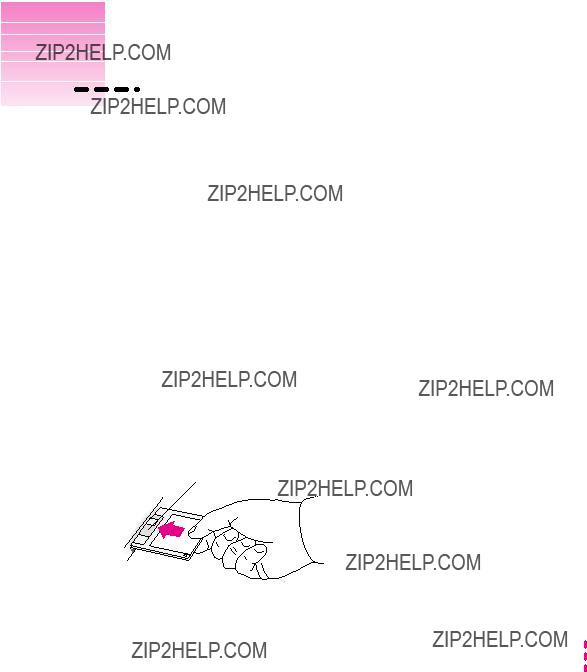
Read this chapter for information on
installing and using application
programs on your computer.
4 Installing and Using Application Programs
Installing application programs
Your computer comes with several application programs already on the hard disk. You???ll find these programs in either the Applications folder or the Apple Extras folder on your hard disk.
A program called Software Highlights gives you easy access to the programs in the Applications folder. To launch these programs and get tips on using them,
You???ll probably want to buy and install additional application programs. Refer to the manuals you receive with your programs for instructions on installing and using them.
In most cases, you install application programs onto your internal hard drive from floppy disks that you receive as part of an application program package. You need to connect an external floppy drive or dock your PowerBook in a Duo Dock before you can install software from a floppy disk. The following illustration shows how to insert a floppy disk in the floppy disk drive.
Insert metal end first, label side up.
41

Working with several programs at a time
You can open as many application programs and desk accessories as your computer???s memory allows.
All open programs are listed in the Application menu at the right end of the menu bar. The name of the active program (the one you???re using right now) has a checkmark next to it, and its icon appears in the menu bar.
The Finder icon
Commands to hide or display open windows
You can also switch to another program by clicking in a window that belongs to an open program, or by
42 Chapter 4

Hiding and showing windows on the desktop
You can hide all windows except those of the active program by choosing
Hide Others from the Application menu.
The other programs remain open even though their windows are hidden.
When you switch to another program, its windows become visible again.
If you want to see all the open windows, choose Show All from the
Application menu.
Backing up your files
Making backup copies of important files is good protection against possible damage to the originals.
mYou can back up files stored on your hard disk by copying them onto floppy disks.
mYou can back up an entire floppy disk by copying it to another floppy disk, or to a hard disk.
mYou can use a commercial backup program to copy new and changed files from a hard disk to another hard disk, to a tape drive, or to a series of floppy disks.
mIf your computer is on a network, you can back up files by copying them to a shared disk on the network.
mYou can back up files by copying them from one computer to the other using SCSI disk mode. (See ???Using Your PowerBook as a SCSI Disk??? in Chapter 3 for more information on SCSI disk mode.)

Read this chapter for information
about your PowerBook???s battery.
5 Power Management
Power sources
Your computer can draw its operating power from two different sources.
mMain battery Your computer???s main power source is a
mAC power You can run your computer from a grounded electrical outlet by plugging in the power adapter.
Your computer also has a backup battery that maintains the contents of RAM while you replace the main battery. The backup battery does not provide enough power to run the computer.
These power sources are described in more detail in the following sections.
Responding to
When the batteries run low, the computer displays a series of
45

What you should do
When you see a
mPlug in the power adapter, or
mSave your work and put the computer to sleep.
What you should know
The first
save power.
If you continue to work without plugging in the power adapter or changing the batteries, the computer displays a second
The second message is followed by a third and final message indicating that the computer is about to put itself to sleep. Within a few seconds, the computer goes to sleep automatically to protect the contents of RAM. All activities are interrupted. It???s a good idea to save your work when you see the first two
If you continue working until the computer goes to sleep automatically, you can wake it again as soon as you plug in the power adapter or replace the battery with a fully charged battery.
If you can???t plug in the power adapter, the contents of RAM are retained in sleep for about a day. If you recharge or change the battery within a day, you should be able to wake the computer and resume work where you left off.
IMPORTANT Recharge a depleted battery as soon as possible. Leaving a depleted battery in the computer for more than several months, or in a hot location (such as the trunk of a car) for longer than two weeks, may damage the battery so that it can???t be recharged. If this happens, you need to replace the battery.
46 Chapter 5

Recharging the battery
There are two ways to recharge a battery:
mPlug in the power adapter to recharge the battery without removing it from the computer.
mRemove the battery and recharge it in the (optional) recharger.
Recharge a battery shortly before you plan to use it. The battery does not retain its charge in
Recharging in the computer
Plug in the power adapter as shown.
WARNING Use only the power adapter that came with your computer. Adapters for other electronic devices (including other portable computers) may look similar, but they may damage your computer.
You can continue to use the computer while the battery is recharging. Using the computer does not affect the amount of time it takes the battery to recharge.
If you are recharging a fully depleted battery, it usually takes a little over 2 hours to bring the battery charge to 100 percent, but the time may vary depending on the model of PowerBook you have and the battery you are recharging.

Recharging in a recharger
You can purchase a battery recharger and additional batteries from your
The recharger can accommodate two batteries. It charges one battery at a time. You can put batteries in or take them out at different times.
The recharger must be plugged into an electrical outlet to charge a battery. You can plug it in using the power adapter that came with your computer, or you can purchase an additional (identical) power adapter from your Apple- authorized dealer.
WARNING Use only the power adapter that came with your computer with the recharger. Using other types of power adapters may damage the recharger, the power adapter, or both.
To recharge a battery, follow these steps:
1Place the recharger on a level surface.
2Connect the recharger and the power adapter as shown in the illustration.
48 Chapter 5

3Place the battery in the recharger as shown.
Recharging begins immediately. You can remove a battery from the recharger at any time. Remember, if you are charging two batteries, they charge one at a time. It takes about two hours to charge each battery.
IMPORTANT To preserve a battery???s charge, don???t leave it in the recharger if the power adapter is not plugged into an electrical outlet.
The lights on the recharger indicate the following:
mNo light Either the recharger is not plugged in, the other battery is being charged (if you have two batteries in the recharger), or the battery is defective. (If the light goes off during recharging, there is a problem with the battery.)
mYellow The battery is charging.
mGreen The battery is fully charged.
mRed The recharger does not recognize the type of battery you inserted. If you are charging a replacement battery, follow the instructions that came with it.

Recharging in both the computer and a recharger
You can use a single power adapter to run the PowerBook and the battery recharger at the same time.
If the PowerBook is on and contains a battery that is not fully charged, the computer charges the internal battery first. The external battery does not begin charging until the internal battery is fully charged. It takes a little over 2 hours for a fully depleted battery to charge.
If the PowerBook is in sleep or is shut down, internal and external batteries charge simultaneously. If both batteries are fully depleted, it takes about 41???2 hours to charge both. If the internal battery is fully charged or absent, the external battery takes a little over 2 hours to charge.
Removing or replacing the battery
mIf the power adapter is plugged in, you can use the computer indefinitely without a battery.
mIf the power adapter is not plugged in, the backup batteries in your computer protect open programs and documents for about 4 minutes, allowing you to remove the depleted battery and replace it with a charged one. (The backup batteries maintain other kinds of information, including control panel settings such as the clock time, for up to two weeks after the main battery is discharged or removed.)
To remove or replace the main battery, follow these steps:
50 Chapter 5

1Save your work, and then choose Sleep from the Special menu.
You can choose Shut Down instead of Sleep if you feel more comfortable working without the
2Close the display.
3Open the battery door by pressing the small button and sliding the door in the direction indicated by the arrow.
The door is physically attached to the battery.
4Carefully pull the battery out of its compartment.
5If you are inserting another battery, slide it into the battery compartment.
Replacement batteries come with a door attached.
6Close the battery door by pushing it back into place.
IMPORTANT Check to make sure the battery is properly inserted. The battery should be aligned with the computer and the battery door completely closed. The top and bottom seams where the battery and the PowerBook meet should be tight and even. If a battery is not inserted correctly, you may have performance problems.
7If possible, plug in the power adapter in case the battery is not fully charged.
WARNING Damaged

Disposing of dead batteries
IMPORTANT
In the United States: Return dead batteries to your
Elsewhere: Many countries have government- or
Replacing the backup battery
In addition to its main battery, your computer has a small backup battery that maintains the contents of RAM while you replace the main battery.
The backup battery usually lasts for several years. You may need to have it replaced if you notice that some of your system settings changed after you removed or replaced the main battery. (You may notice, for example, that the clock time is different.) By replacing the backup battery you can preserve the contents of RAM the next time you change the main battery.
Your computer???s backup battery must be replaced by an
52 Chapter 5

Reconditioning the battery
To maximize battery life, you should recondition the battery once every 30 days, using the Battery Reconditioning program, which is on the system software disk labeled Disk Tools. You may want to keep a copy of the Battery Reconditioning program on your hard disk so it is more convenient to use every 30 days.
IMPORTANT It takes 2 hours to run the Battery Reconditioning program and another 2 hours to fully charge your battery in your PowerBook. During the time you are reconditioning your battery (and recharging it, if you don???t have a recharger), you cannot use your PowerBook. Plan to recondition your battery when you won???t need your PowerBook for at least 4 hours.
To recondition a battery, follow these steps:
1Make sure your PowerBook is connected to a power source.
If you have already copied the Battery Reconditioning program to your hard disk, skip step 2 and do step 3 next.
2Insert Disk Tools in the floppy disk drive and turn on your PowerBook.
3Locate the Battery Reconditioning icon and open it.
A message appears on the screen describing battery reconditioning. If you don???t have your PowerBook plugged in, a message appears telling you to plug it in.

4 Read the message on the screen and click OK.
The following appears:
The type of battery in your computer appears here.
The date you last reconditioned your battery appears here. A warning appears below the date if it has been less than 30 days since the last time you reconditioned the battery.
5Click Recondition if it has been more than 30 days since the last time you reconditioned the battery.
If 30 days have not passed since the last time you reconditioned, the following appears on the screen:
Click Quit to exit the Battery Reconditioning program.
If 30 days have passed since you last reconditioned, this message appears:
Remember that it takes 2 hours to recondition the battery and 2 hours to fully charge the battery. Make sure you do not need to use your PowerBook for 4 hours.
54 Chapter 5

6Click OK.
While the reconditioning cycle is taking place, the following icon appears on the screen:
You can quit the Battery Reconditioning program at any time by pressing the period key and the x (Command) key at the same time. Also, if you unplug your PowerBook during reconditioning, the reconditioning program will quit. Your battery is not reconditioned if you quit in the middle of the reconditioning cycle.
When the reconditioning is complete, the following appears on the screen for one minute:
7Click OK.
The battery is reconditioned. Allow time to recharge the battery by leaving the PowerBook plugged in for 2 hours. Follow these steps again in 30 days to maximize the life of the battery.
Maximizing work time
Your PowerBook???s battery can provide 2 to 7 hours of work time before you need to recharge. The actual work time available depends on what equipment you???re using with your computer and what steps you take to conserve power while you work.
For battery conservation tips, see the ???Batteries & Power??? topic of Macintosh Guide, available in the Guide (h) menu.

Refer to this appendix for important
and safety tips.
Appendix A
Health, Safety, and Maintenance Tips
Muscle soreness, eye fatigue, and other discomforts and injuries sometimes associated with using computers can occur from performing any number of activities. In fact, misuse of the same muscles during multiple activities can create a problem that might not otherwise exist. For example, if you engage in nonwork activities that involve repetitive stress on the
The most common health effects associated with using a computer are musculoskeletal discomfort and eye fatigue. We???ll discuss each area of concern below.
57

Musculoskeletal discomfort
As with any activity that involves sitting for long periods of time, using a computer can make your muscles sore and stiff. To minimize these effects, set up your work environment carefully, using the guidelines that follow, and take frequent breaks to rest tired muscles. To make working with your computer more comfortable, allow enough space in your work area so that you can change position frequently and maintain a relaxed posture.
Another type of musculoskeletal concern is repetitive stress injuries (RSIs), also known as cumulative trauma disorders (CTDs). These problems can occur when a certain muscle or tendon is repeatedly overused and forced into an unnatural position. The exact causes of RSIs are not totally understood, but in addition to awkward posture, such factors as the amount of repetition, the force used in the activity, the individual???s physiology, workplace stress level, and lifestyle may affect the likelihood of experiencing an RSI.
RSIs did not suddenly arise when computers were invented; tennis elbow and writer???s cramp, for example, are two RSIs that have been with us for a long time. Although less common than other RSIs, one serious RSI discussed more often today is a wrist problem called carpal tunnel syndrome, which may be aggravated by improper use of computer keyboards. This nerve disorder results from excessive pressure on the median nerve as it passes through the wrist to the hand.
This section offers advice on setting up your work area to enhance your comfort while you use your computer. Since the effects of repetitive movements associated with using a computer can be compounded by those of other work and leisure activities to produce or aggravate physical problems, proper use of your computer system must be considered as just one element of a healthy lifestyle.
No one, of course, can guarantee that you won???t have problems even when you follow the most expert advice on using computer equipment. You should always check with a qualified health specialist if muscle, joint, or eye problems occur.
58 Appendix A

Eye fatigue
Eye fatigue can occur whenever the eyes are focused on a nearby object for a long time. This problem occurs because the eye muscles must work harder to view an object that???s closer than about 20 feet (6 meters). Improper lighting can hasten the development of eye fatigue. Although eye fatigue is annoying, there???s no evidence that it leads to permanent damage.
Whenever you???re engaged in an activity that involves
To prevent discomfort and eye fatigue:
mArrange your work space so that the furniture is properly adjusted for you and doesn???t contribute to an awkward working posture.
mTake frequent short breaks to give your muscles and eyes a chance to rest.
Arranging your work area and equipment
The suggestions in this section can help you work more comfortably with your computer.
Chair
mAn adjustable chair that provides firm, comfortable support is best. Adjust the height of the chair so your thighs are horizontal and your feet flat on the floor.
The back of the chair should support your lower back (lumbar region). Follow the manufacturer???s instructions for adjusting the backrest to fit your body properly.

Keyboard and trackball
mWhen you use the keyboard and trackball, your shoulders should be relaxed. Your upper arm and forearm should form an approximate right angle, with your wrist and hand in roughly a straight line.
mYou may have to raise your chair so your forearms and hands are at the proper angle to the keyboard. If this makes it impossible to rest your feet flat on the floor, you can use a footrest with adjustable height and tilt to make up for any gap between the floor and your feet. Or you may lower the desktop to eliminate the need for a footrest. Another option is to use a desk with a keyboard tray that???s lower than the regular work surface.
mUse a light touch when typing or using the trackball and keep your hands and fingers relaxed. When using the trackball or keyboard, avoid rolling your thumbs under your palms.
Some computer users may develop discomfort in their hands, wrists, or arms after intensive work without breaks. If you begin to develop chronic pain or discomfort in your hands, wrists, or arms, consult a qualified health specialist.
60 Appendix A

mChange hand positions often to avoid fatigue.
mIf you prefer, you can adjust the angle of the keyboard by lowering the legs until they snap into position.
The back of the keyboard is slightly elevated when the legs are in use. Otherwise, the keyboard is level.
Mouse
mIf you use a mouse, position the mouse at the same height as your keyboard. Allow adequate space to use the mouse comfortably.
mAdjust the angle of the display to minimize glare and reflections from overhead lights and windows.
mIf your display screen has manual brightness and contrast controls, you may need to adjust the brightness and contrast of the screen when you take the computer from one work location to another, or if the lighting in your work area changes.
External monitor
If you use an external monitor, this suggestion may be helpful.
mIf possible, arrange the monitor so the top of the screen is slightly below your eye level when you???re sitting at the keyboard. The best distance from your eyes to the screen is up to you, although most people seem to prefer 18 to 28 inches (45 to 70 cm).

Avoiding fatigue
mChange your seated position, stand up, or stretch whenever you start to feel tired. Frequent short breaks are helpful in reducing fatigue.
mAllow adequate work space so that you can work comfortably. Place papers or other items so you can view them easily while using your computer. A document stand may make reading papers more comfortable.
mEye muscles must work harder to focus on nearby objects. Occasionally focus your eyes on a distant object, and blink often while you work.
mClean your screen regularly. Keeping the screen clean helps reduce unwanted reflections.
What about electromagnetic emissions?
There has been recent public discussion of the possible health effects of prolonged exposure to extremely low frequency (ELF) and very low frequency (VLF) electromagnetic fields. Such fields are associated with electromagnetic sources such as television sets, electrical wiring, and some household
Apple has reviewed scientific reports and sought the counsel of government regulatory agencies and respected health organizations. Based on the prevailing evidence and opinions, Apple believes that the electric and magnetic fields produced by computer monitors do not pose a health risk. In response to those customers who wish to reduce their exposure to electromagnetic fields, Apple has lowered the emission levels of its products.
62 Appendix A

Important care and safety instructions
For your own safety and that of your equipment, read and follow all the instructions in this section. Keep these instructions available for reference by you and others.
Warning
mElectrical equipment may be hazardous if misused. Operation of this product, or similar products, must always be supervised by an adult. Do not allow children access to the interior of any electrical product and do not permit them to handle any cables.
mDo not use the computer in or near water.
mDo not use cables that are frayed or otherwise damaged. Hold a cable by its connector (the plug, not the cord) when connecting or disconnecting it.
mAlways handle batteries carefully.
mDo not drop, puncture, mutilate, or burn the computer or battery.
mRecharge batteries only as described in this manual and only in ventilated areas.
mTransport batteries either inside the computer or in the protective case provided with each battery. Do not transport unprotected batteries.
mDo not

Caution
mIf you have a problem with your computer and nothing in the computer manuals solves the problem, take the computer to your
mDo not move the computer when you can hear its hard disk spinning. When you put the computer to sleep, wait until the screen is blank before moving the computer.
mUse only the power adapter supplied with your computer, or an identical model. Adapters designed for other electronic devices may look similar, but they may not work with your computer and may damage it.
mNever force a connector into a port. Make sure that the connector matches the port and that it???s
mDo not use the computer in wet or dusty environments.
mKeep dirt and liquids away from the ports on the back panel, the keyboard, and the trackball. If you spill any food or liquid onto the computer, shut it down immediately and unplug it before cleaning up the spill. Depending on what you spilled and how much got into the computer, you may have to bring the computer to an
mDo not touch the screen with any sharp or pointed objects.
mUse only the battery supplied with your computer. Batteries designed for other portable computers may look similar, but they may not work with your computer and may damage it.
mWhen recharging the battery, use only the power adapter supplied with your computer, or an identical model. Adapters designed for other electronic devices may not work with your equipment and may damage the computer or the recharger.
mDo not leave batteries in hot locations (such as the trunk of a car).
64 Appendix A

Important
mUse the computer only in environments where the temperature range> is between 50??F/10??C and 104??F/40??C.
mDo not expose the computer to very low (less than
mIf the computer has been in a cold place for several hours, let it warm up to room temperature before you use it.
mClean the computer???s outside surfaces with a damp (not wet) cloth. Clean the screen with soft,
Caring for batteries
mAlways handle batteries carefully.
mDo not
mDo not drop, puncture, disassemble, mutilate, or incinerate the battery.
mRecharge batteries only as described in this manual and only in ventilated areas.
mDo not leave batteries in hot locations (such as the trunk of a car).
mDo not leave a battery in your computer for longer than a week without plugging in the power adapter.
mDo not leave a battery in storage for longer than 6 months without recharging it.
mTake dead batteries to an

Handling floppy disks
50?? F (10?? C)
66 Appendix A

Traveling with the PowerBook
The safety instructions earlier in this appendix also apply when you are traveling. In addition, note these precautions:
mDo not transport your PowerBook while it is turned on. Put your computer to sleep or shut it down before you move it.
mTransport batteries either inside the computer or in the protective case provided. Do not transport unprotected batteries.
mDo not check your computer as baggage. Carry it with you.
mHave security officials manually inspect your computer and disks if you do not want to pass them through
mBe prepared to show security officials that your computer is working. Have a charged battery or a power adapter ready to use.
mSome airlines may restrict or prohibit the use of computers in flight. Check ahead to find out what restrictions, if any, apply.
mTake the necessary plug adapters if you???re traveling overseas. (You may need to use them with the power adapter.) You do not need a voltage transformer. The power adapter can handle 90 volts to 260 volts AC (48 Hz to 62 Hz).
Check the diagrams below to determine which plug adapters you???ll need, or ask your travel agent.

Storing the PowerBook
1Save your work on a hard disk or floppy disks.
2Choose Shut Down from the Special menu.
3Close the display.
4Recharge the battery.
Be sure your battery is fully charged if you are taking the computer places where you cannot plug it in.
5Store the computer in a cool, dry place.
Storage temperatures should remain between 10??C and 40??C (between 50??F and 104??F). Avoid leaving the computer where temperatures may be extreme or
Service and support
If your computer is malfunctioning but does not appear to be physically damaged, shut it down (and leave the power adapter plugged in, if possible) until you can get help.
If you know or suspect that your computer is physically damaged, disconnect the power adapter, remove the battery, and do not use the computer until it can be repaired.
See the service and support information that came with your computer for information about customer assistance.
68 Appendix A

Refer to this appendix for
information on using the
PowerBook 200 Series keyboard.
Appendix B
Using Your Keyboard
The PowerBook 200 Series keyboard works in much the same was as the keyboards on other computers and on electric typewriters. However, there are a few special keys you should know about.
The illustration on the following page explains the function of all the special keys on the PowerBook 200 Series keyboard.
69

Special keys on the PowerBook 200 Series keyboard
Delete key Return key
Tab key
Caps lock key
Control key Option key
70 Appendix B

If you can???t find what you???re looking for in this index, look in Macintosh Guide??? available in the Guide (h) menu on your computer.
Index
A
About this Macintosh (Apple menu) 40 activating the Finder 16, 23
active program 16, 42
disposing of dead batteries 52, 65 installing additional RAM 40 repairing the computer 64 replacing the backup battery 52
Apple Desktop Bus (ADB) port Duo Dock II 28, 29
Duo MiniDock 30
Apple
Apple
Finder 16, 23
Hide Others command 43

batteries
avoiding damage to 46 backup battery 45, 50, 52 care of 63, 64, 65 damaged
disposing of dead batteries 52, 65
disk mode 38 maximizing work time 55 recharging 1,
battery power conserving 12, 55
SCSI disk mode and 38 battery recharger
Battery Reconditioning program
troubleshooting 6 brightness on screen, adjusting 5, 61 burns to skin and eyes from damaged
batteries 51
C
cables
Apple
Apple
SCSI system cable 36
cable terminators, for connecting SCSI devices
care of equipment. See safety instructions carpal tunnel syndrome 58
chair, adjusting for computer use 59, 60 charging batteries 1,
cleaning the computer 65 clicking icons 25
close box 10
closing the Macintosh Guide window 23 commands, shortcuts for
See safety instructions connecting
additional equipment, overview
external input devices 40 external modem
Duo Dock II
SCSI devices
conserving battery power 12, 38, 55 contrast on screen, adjusting 61 control panels
Express Modem 33
PowerBook Setup 36 Control Strip 10 copying files 43
cumulative trauma disorders (CTDs) 58 customer support 14, 68
72 Index

D
damaged batteries
damage to computer, avoiding 1, 40, 46 dead batteries, disposing of 52, 65 desk accessories, opening and
switching 42 desktop, hiding and showing
disconnecting the PowerBook in SCSI disk mode 38, 39
Disk Tools disk 53 display. See also screen
docking connection 27
Duo Floppy Adapter 31 Duo MiniDock 30
SCSI disk mode and 35
E
ejecting PowerBook from Duo Dock II 28
electromagnetic emissions from computer monitors 62
Empty Trash command (Special menu) 10
equipment, adjusting and arranging for optimal use
Ethernet port (Duo Dock II) 28 EtherTalk port (Duo Dock II) 29 expanding
the Macintosh Guide window 23 your system
Express Modem control panel 33 external modem, connecting
Duo Dock II 28, 32 Duo MiniDock 30, 32
external monitor, adjusting 61 eye fatigue related to computer use
F
files, backing up 43 Finder
shortcuts in
floppy disk drive (Duo Dock II) 28, 29 floppy disk drive port
(Duo MiniDock) 30 floppy disks
backing up 43
Index 73

Guide menu
Hide Balloons command 24 how to use
Macintosh Guide command 16 Macintosh Tutorial 9 overview 10, 14
Shortcuts command 25 Show Balloons command 24
H
handling computer equipment. See safety instructions
hard disk
backing up files on 43 in Duo Dock II 43
hard disk icon 10
hard disk space, using as RAM 40
computer use
Help. See Guide menu; Macintosh Guide; troubleshooting
Hide Balloons command (Guide menu) 24
Hide Others command (Application menu) 43
hiding windows on the desktop 43 Huh? button (Macintosh
Guide window) 23
icons
Battery Reconditioning 53 blinking question mark 6 defined 10
dimmed 42
Guide menu 15 hard disk 10 modem port 32 opening 25 ports 27, 28, 30
PowerBook Setup 36 printer/modem port 32 SCSI ID 37
SCSI disk mode 37, 38 identifying objects on the screen 24 ID number. See SCSI ID number Index button (Macintosh
Guide window) 17,
internal modem 33 internal modem port
74 Index

K
keyboard
adjusting angle of 61 care of 64
correct posture for using
L
liquid spills on the computer 64 Look For button (Macintosh
Guide window) 17,
SCSI disk mode 38
M
Macintosh Guide command (Guide menu) 16
Macintosh Guide closing 22, 23 displaying 16
finding information
Index button 17,
returning to 18, 23 shrinking and expanding 23 tips for using 23
Topics button
Macintosh Shortcuts
memory upgrade cards 40 menu, defined 9
menu bar, defined 10 modem, connecting
Duo Dock II 28, 29
Duo MiniDock 30
monitor power socket (Duo Dock II) 28 mouse
correct position of 61 shortcuts for using
moving
batteries 63, 67
the computer 64, 67
the Macintosh Guide window 23 musculoskeletal discomfort related to
computer use
N
network, backing up files on 43
See batteries
NuBus slots (Duo Dock II) 28, 29
Index 75

O
opening
applications and desk accessories 42 the display 3
icons 25
open programs, displaying 42
P
plug adapters for overseas travel 67 plugging in the computer
ports, illustration of Duo Dock II 28 PowerBook 27
PowerBook Duo MiniDock 30 power adapter 1, 2, 5, 64
recharging batteries and
power adapter port Duo MiniDock 30 PowerBook 2, 27
PowerBook Duo 280c, sleep and 12 PowerBook Duo Floppy Adapter 31 PowerBook Duo MiniDock 30
SCSI disk mode and 35
PowerBook Setup control panel 36
PowerBook Troubleshooting Guide
5, 6, 14 power button
Duo Dock II 28 Duo MiniDock 30
PowerBook 5, 11, 13, 27, 37 power conservation 12, 38, 55 power cord 1, 2
Power On key 4 troubleshooting 5
power socket (Duo Dock II) 28 power sources 45
printer, connecting 31 printer/modem port (PowerBook)
Duo Dock II 28, 29
Duo MiniDock 30 problems. See troubleshooting
programs. See application programs
Q
question mark on screen, troubleshooting 6
questions. See Guide menu; Macintosh Guide; troubleshooting
76 Index

R
RAM
installing 40
protecting contents of 46 RAM disk 13
recharging batteries 1,
repetitive stress injuries (RSIs) 58 replacing the backup battery 52 Restart command (Special menu) 13 restarting the computer 13
S
safety instructions
connecting SCSI equipment 34, 35, 37
damaged batteries
general instructions for computer equipment
grounding plug 2
installing additional RAM 40 power adapter 1
recharging the battery 47, 48 storing the computer 68 transporting batteries 63, 67 transporting the computer 64, 67
screen. See also display adjusting brightness and
contrast of 61 identifying objects on 24 troubleshooting 5
scroll arrows 10
SCSI cable terminators adding
SCSI devices, connecting
PowerBook as
PowerBook 36 SCSI port
Duo Dock II 28, 29, 34 Duo MiniDock 30, 34, 36
SCSI system cable 36
searching for information, Macintosh Guide window
security slot
Duo Dock II 28 Duo MiniDock 30
setting up the computer
Index 77

Shortcuts command (Guide menu) 25 Show All command
(Application menu) 43 Show Balloons command
(Guide menu) 24
showing windows on the desktop 43 shrinking the Macintosh
Guide window 23
Shut Down command (Special menu) 11, 37, 51, 68
shutting down the computer, troubleshooting 11, 37
size box 10
sleep, putting the computer to sleep 12, 46
Sleep command (Special menu) 12, 51 Small Computer System Interface.
See SCSI
Software Highlights program 41 sound in and out ports
Duo Dock II 28, 29
Duo MiniDock 30 Special menu
Empty Trash command 10 Restart command 13
Shut Down command 11, 37, 51, 68 Sleep command 12, 51
spills, cleaning up 64
starting up the computer 4 storing the computer 68
support, obtaining customer assistance 14, 68
switching to another program or desk accessory 42
???system error??? message 13 system software 6
T
Tab key 70
tape drive, copying files to 43 temperature ranges
for the computer 65 for floppy disks 66
terminators. See cable terminators
title bar 10
Topics button (Macintosh Guide window)
Topics button (Macintosh Shortcuts window) 26
trackball care of 64
78 Index

transferring information between computers 35
transporting batteries 63, 67
traveling with the computer
blinking question mark on screen 6 external modem problems 33 nothing appears on the screen 5 Power On key 5
restarting the computer 13 shutting down the computer 11, 37 ???system error??? message 13 turning on the computer
turning off the computer 11 quitting SCSI disk mode and 39
turning on the computer 4 SCSI disk mode and 37 troubleshooting
typing, correct posture for 60
U
upgrading memory 40
V
virtual memory 40
VRAM included with Duo Dock and Duo Dock II 29
W, X, Y, Z
waking the computer 11, 12 wall mount plug 2
warranty on your computer 40, 64 windows
defined 10
displaying in applications 42 hiding and showing on desktop 43
working with several programs at a time 42
work space and equipment, optimal arrangement of 58,
Index 79
???
Apple Computer, Inc.